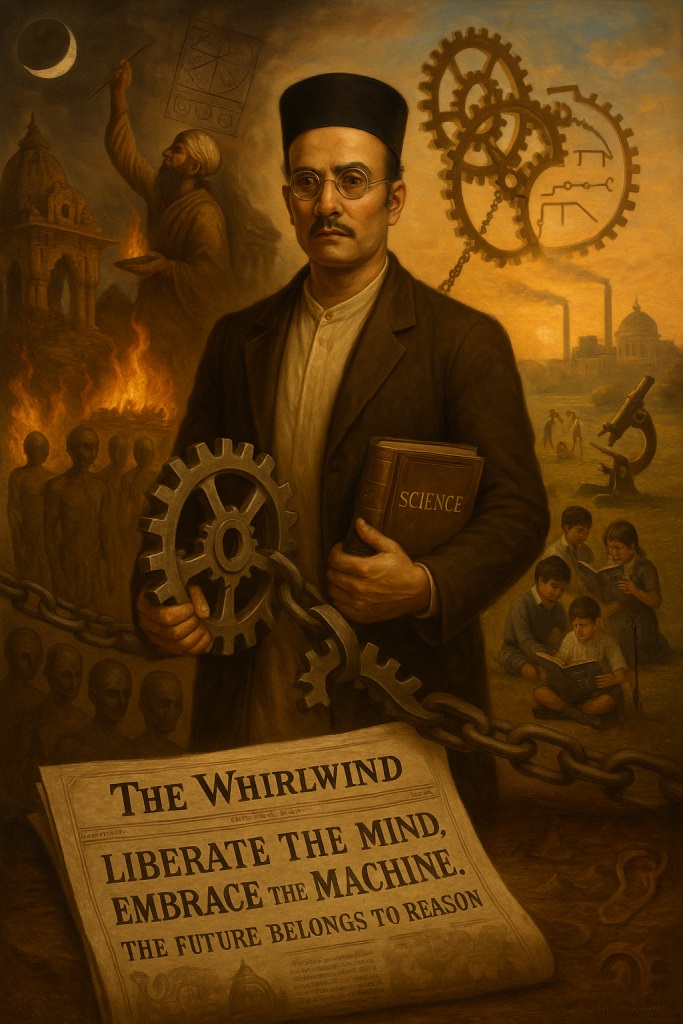Social-Reformist Dimension of Hindutva, Part 4, Savarkar’s Scientific Worldview Against Superstition (1/3)
Savarkar’s Vision: Science Over Superstition, Machines Over Mysticism
Vinayak Damodar Savarkar presented a compelling vision for India’s modernization. His intellectual journey, marked by a deep engagement with diverse ideologies, led him to a stark conclusion: India’s progress hinged on a decisive shift from a “Dharma-dominated mind” to a “science-driven society”.
By meticulously comparing Savarkar’s insights gleaned from his studies of Islam, Hindu Shastras, and Western socio-political thought, we can understand the genesis of his fervent opposition to irrationalism and social inequality. This wasn’t a sudden outburst, but a logical consequence of his analytical mind grappling with the realities of his time. He recognized that to truly advance, India needed an educational system rooted in scientifically verifiable values, fostering a practical and rational worldview.
Savarkar saw a clear correlation between the prevalence of superstition and the resistance to scientific and technological advancements. He was deeply troubled by the pervasive influence of irrationalism in Indian life. He believed that clinging to ancient religious and mystical justifications was obsolete in an age where modern science offered consistent and logical explanations for natural phenomena.
His “rational-pragmatic-scientific materialism” advocated for two primary directives: first, understanding the causal factors of natural events, and second, embedding a scientific perspective in every facet of national life. He believed that the age of Dharma-based national life was over. He envisioned a future built on a solid scientific foundation.
To achieve this, Savarkar employed a dual strategy:
- Liberating the Social Mind: He aimed to dismantle the anti-reason attitude and blind faith in unscientific superstitions, which he attributed to the “negative influence” of Sanatana Dharma. He sought to free the “Social Mind” from the shackles of irrationality.
- Hypostatizing the Machine: He promoted the machine as a symbol of modernity. He recognized that embracing technology was crucial for India’s progress.
This strategy can be summarized as:
- The Transformation of the “Dharma-Dominated Mind”: Moving away from traditional religious dominance and embracing a rational, secular outlook.
- The Acceptance of the “Machine as a Symbol of Modernity”: Recognizing the importance of technology and industrialization in shaping a modern nation.
Savarkar’s concept of enlightenment highlighted the inherent conflict between Dharma and science. He understood that a nation aspiring for a sustainable future must prioritize scientific reasoning over outdated traditions. His writings and campaigns reflect a relentless pursuit of this vision, advocating for an uncompromising transformation of the “Hindu mind” under modern considerations.
His efforts to foster a pro-modernity sentiment and sharpen a scientific guiding principle were aimed at propelling India into the future, a future defined by reason, progress, and a scientific worldview.
How relevant do you think Savarkar’s concept of a “Dharma-dominated mind” versus a “science-driven society” is in today’s world? What are your thoughts on Savarkar’s idea of “hypostatizing the machine” as a symbol of modernity? Share your insights in the comments below!
Sources:
DESHPANDE, Sudhakar. 1999. Savarkar. The Prophetic Voice. Dastane Ramchandra & Co.: Pune.


Leave a Reply